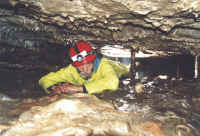|

Mick in the squeeze above Poetic Justice, County Pot
|
Flat-out Crawls/Squeezes When
the gap between the roof and the floor is a eighteen inches or less the
caver is forced onto his/her belly. Forward progress in flat-out
crawls is made on the elbows and toes. Squeezes
are probably the thing that novices cavers fear the most. Usually
squeezes are entered with one arm out in front and the other trailing by
the body. Being relaxed when tackling squeezes is essential as
muscles tense and expand when the caver panics with the obvious
consequence resulting in the pronouncement,
"Oh botheration, I appear to be a tad stuck here." |

|